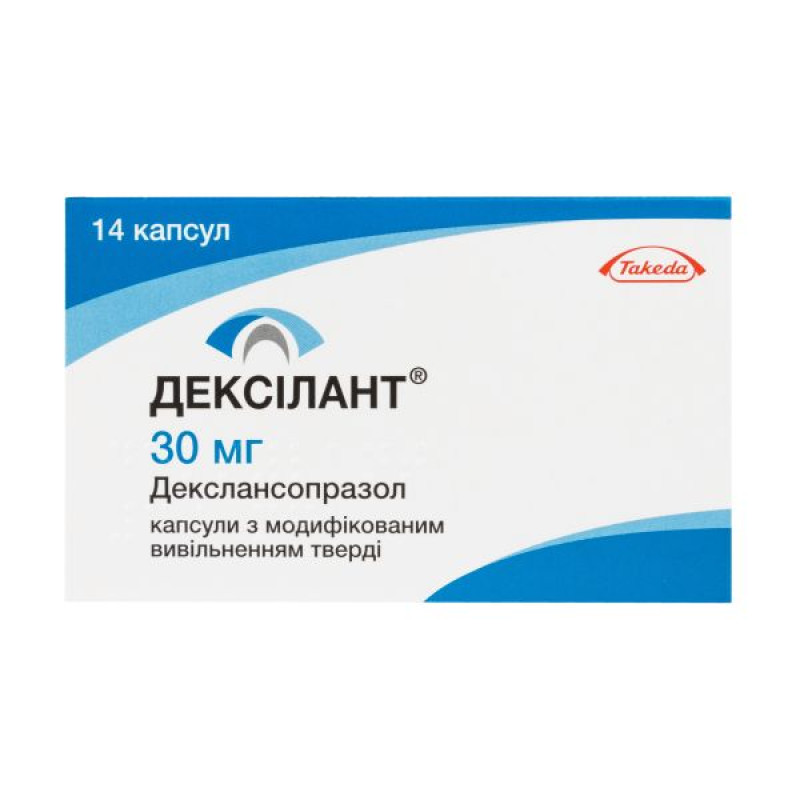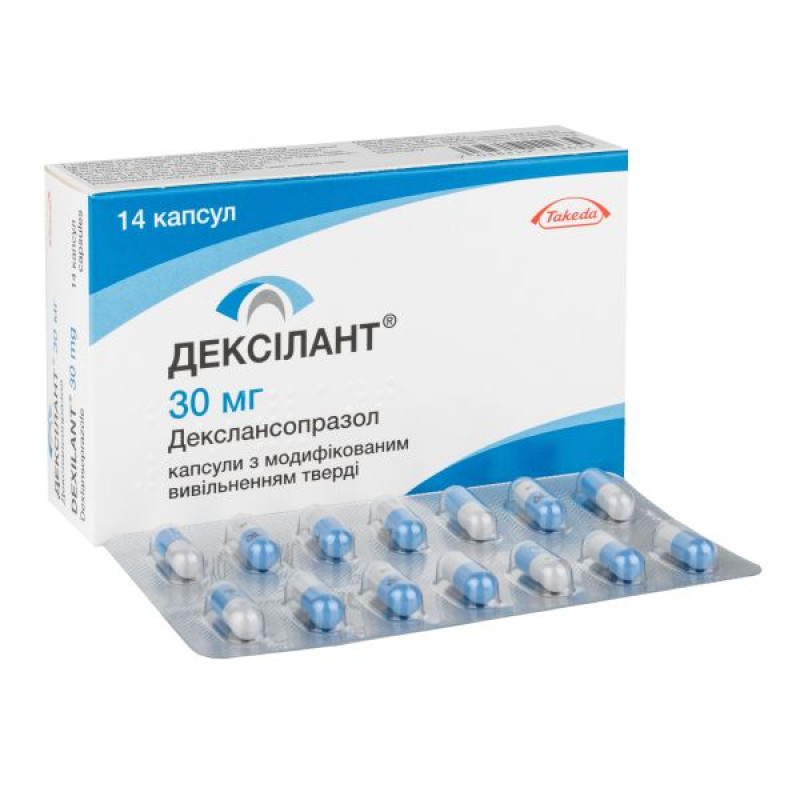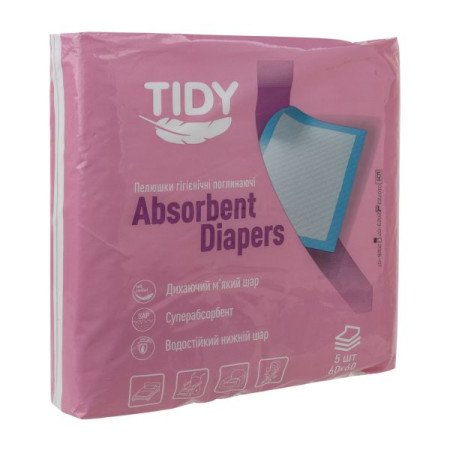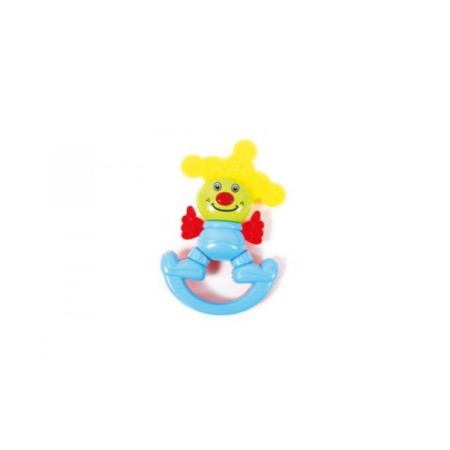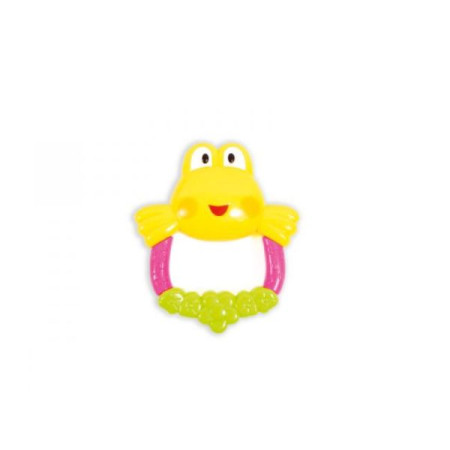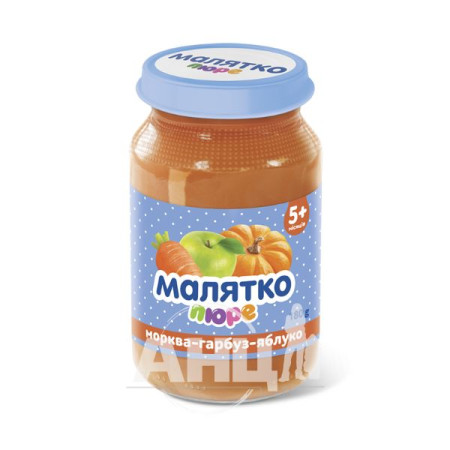Dexilant modified-release hard capsules 30 mg No. 14
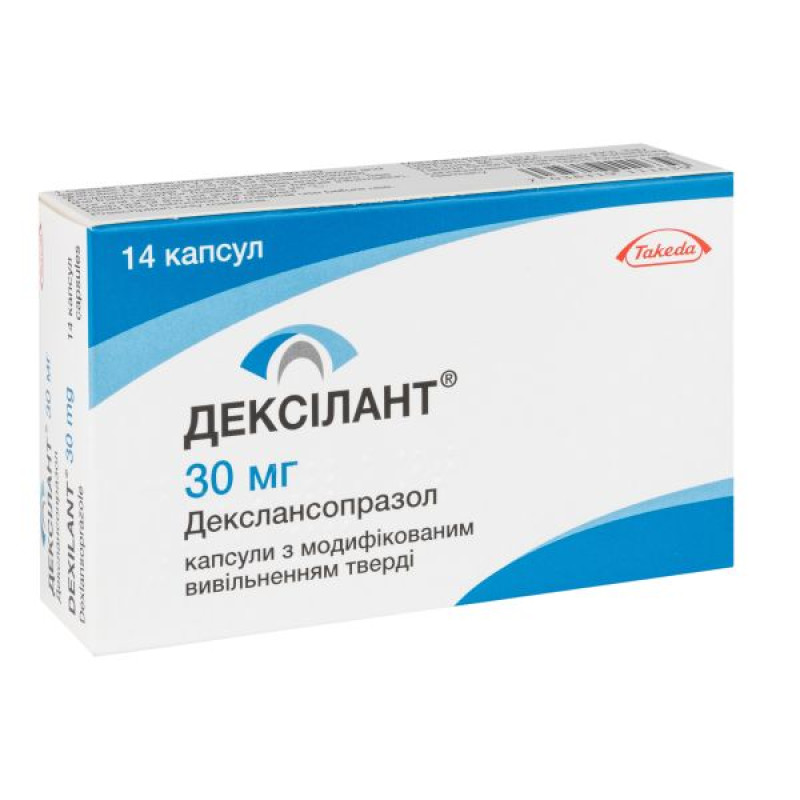
Instructions for Dexilant modified-release hard capsules 30 mg No. 14
Composition
active ingredient: dexlansoprazole;
1 capsule contains 30 mg of dexlansoprazole (LL-granules – 7.5 mg of dexlansoprazole and H-granules – 22.5 mg of dexlansoprazole) or 60 mg of dexlansoprazole (LS-granules – 15 mg of dexlansoprazole and H-granules – 45 mg of dexlansoprazole);
excipients:
granules-LL: spherical sugar; magnesium carbonate; sucrose; low-substituted hydroxypropyl cellulose; hydroxypropyl cellulose; hypromellose 2910; talc; titanium dioxide (E 171); methacrylate copolymer dispersion; polyethylene glycol 8000; polysorbate 80; colloidal anhydrous silicon dioxide;
granules-LS spherical sugar; magnesium carbonate; sucrose; low-substituted hydroxypropyl cellulose; hydroxypropyl cellulose; hypromellose 2910; talc; titanium dioxide (E 171); methacrylate copolymer dispersion; polyethylene glycol 8000; polysorbate 80; colloidal anhydrous silicon dioxide;
granules-H: spherical sugar; magnesium carbonate; sucrose; low-substituted hydroxypropyl cellulose; hydroxypropyl cellulose; hypromellose 2910; talc; titanium dioxide (E 171); methacrylate copolymer (type B); methacrylate copolymer (type A); triethyl citrate; colloidal anhydrous silicon dioxide.
Dosage form
Modified-release capsules are hard.
Main physicochemical properties:
30 mg capsules: capsules with a blue opaque cap with dark gray engraving "TAR" and a gray opaque body with dark gray engraving "30", containing white to almost white granules;
60 mg capsules: capsules with a blue opaque cap with dark gray engraving "TAR" and a blue opaque body with dark gray engraving "60", containing white to off-white granules.
Pharmacotherapeutic group
Proton pump inhibitors. ATC code A02B C06.
Pharmacological properties
Pharmacodynamics: Dexlansoprazole belongs to the class of antisecretory compounds, which are substituted benzimidazoles that inhibit gastric acid secretion by specifically inhibiting the activity of (H+, K+)-ATPase on the secretory surface of gastric parietal cells. Since this enzyme system is considered the acid (proton) pump of the parietal cells, dexlansoprazole is classified as a proton pump inhibitor, which blocks the final step in acid formation.
Pharmacokinetics. Absorption. After oral administration of Dexilant® at doses of 30 mg or 60 mg to healthy volunteers and patients with symptomatic gastroesophageal reflux disease, the mean Cmax and AUC of dexlansoprazole increased almost proportionally to dose.
When 60 mg of Dexilant® granules are mixed with water and administered via nasogastric tube or orally using a syringe, the bioavailability (Cmax and AUC) of dexlansoprazole is the same as when 60 mg of Dexilant® is administered as an intact capsule.
Food intake does not affect the AUC of dexlansoprazole.
Distribution: Plasma protein binding of dexlansoprazole in healthy volunteers ranged from 96% to 99% and was independent of drug concentration over the range of 0.01 to 20 μg/mL. In patients with symptomatic gastroesophageal reflux disease, the apparent volume of distribution (Vz/F) after multiple doses was 40 L.
Metabolism: Dexlansoprazole is extensively metabolized in the liver by oxidation, reduction, and subsequent sulfate formation, conjugation with glucuronide, and glutathione to inactive metabolites. Oxidized metabolites are formed by the cytochrome P450 (CYP) enzyme system, including hydroxylation mainly by CYP2C19 and oxidation to the sulfone by CYP3A4.
CYP2C19 is a polymorphic hepatic enzyme that exhibits three phenotypes in the metabolism of CYP2C19 substrates: extensive metabolizers, intermediate metabolizers, and poor metabolizers. Dexlansoprazole is the major circulating component in plasma, regardless of CYP2C19 metabolic status. In extensive and intermediate CYP2C19 metabolizers, the major plasma metabolites are 5-hydroxydexlansoprazole and its glucuronide conjugate, while in poor CYP2C19 metabolizers, the major plasma metabolite is dexlansoprazole sulfone.
Excretion: Following administration of Dexilant®, unchanged dexlansoprazole is not excreted in the urine. Following administration of 14C-labeled dexlansoprazole to 6 healthy volunteers, approximately 50.7% (standard deviation (SD): 9.0%) of the administered radioactivity was excreted in the urine and 47.6% (SD: 7.3%) in the feces. The apparent clearance (CL/F) in healthy volunteers ranged from 11.4 to 11.6 L/h after 5 days of once-daily dosing with 30 mg or 60 mg.
Special patient groups
Pediatric population
The pharmacokinetics of dexlansoprazole in patients under 12 years of age have not been studied.
Patients aged 12 to 17 years
Elderly patients: The terminal half-life of dexlansoprazole is significantly longer in elderly patients compared to younger patients (2.2 and 1.5 hours, respectively). The systemic exposure (AUC) of dexlansoprazole is higher (by 34%) in elderly patients than in younger patients.
Gender: A study involving 12 male and 12 female patients receiving a single 60 mg oral dose of Dexilant® showed that female patients had a higher systemic exposure (AUC) (by 43%) than male patients. This difference in exposure does not affect the safety profile of the drug.
Renal impairment. Dexlansoprazole is extensively metabolized in the liver to inactive metabolites, so the parent drug is not detected in the urine after oral administration of dexlansoprazole. Therefore, the pharmacokinetics of dexlansoprazole are not expected to be different in patients with renal impairment. Studies involving patients with renal impairment have not been conducted. In addition, the pharmacokinetics of lansoprazole were not clinically different in patients with mild, moderate, or severe renal impairment compared to healthy volunteers.
Hepatic impairment. A study in 12 patients with moderate hepatic impairment (Child-Pugh B) given a single 60 mg oral dose of Dexilant® showed that systemic exposure to bound and unbound dexlansoprazole was approximately 2-fold higher than that in healthy volunteers. This difference in exposure was not due to differences in plasma protein binding. Studies in patients with severe hepatic impairment (Child-Pugh C) have not been conducted (see Dosage and Administration).
Indication
Treatment of all stages of erosive esophagitis in patients aged 12 years and older for up to 8 weeks.
Maintenance treatment of erosive esophagitis and relief of heartburn in patients aged 12 years and older for up to 6 months for adult patients and 16 weeks for patients aged 12 to 17 years.
Treatment of heartburn associated with symptomatic non-erosive gastroesophageal reflux disease in patients aged 12 years and older for 4 weeks.
Contraindication
Hypersensitivity to the active substance or to any of the excipients. Hypersensitivity reactions may include anaphylaxis, anaphylactic shock, angioedema, bronchospasm, acute tubulointerstitial nephritis and urticaria (see sections 4.4 and 4.8). Proton pump inhibitors (PPIs), including Dexilant®, are contraindicated when used concomitantly with rilpivirine-containing products (see section 4.5).
Interaction with other medicinal products and other types of interactions
Clinically significant drug interactions and changes in diagnostic test results when used concomitantly with Dexilant®, as well as measures to prevent or eliminate them, are listed below.
For more detailed information on interactions with proton pump inhibitors, see the prescribing information for the respective medicinal products.
Drugs and diagnostic tests on which Dexilant® has a clinically significant effect
Antiretroviral drugs. Clinical effects. The effects of PPIs on antiretroviral drugs are variable. The clinical significance and mechanisms of these interactions are not known in all cases.
Reduced exposure of some antiretroviral drugs (e.g. rilpivirine, atazanavir and nelfinavir) when co-administered with dexlansoprazole may reduce antiviral activity and lead to the development of drug resistance.
Increased exposure to other antiretroviral drugs (e.g. saquinavir) when co-administered with dexlansoprazole may increase the toxicity of antiretroviral drugs.
There are other antiretroviral drugs whose interactions with dexlansoprazole are not clinically significant.
Measures: Rilpivirine-containing products: concomitant use with Dexilant® is contraindicated (see section “Contraindications”).
Atazanavir: See the atazanavir prescribing information for dosage.
Nelfinavir. Concomitant use with Dexilant® should be avoided. See the prescribing information for nelfinavir.
Saquinavir: See saquinavir prescribing information; monitoring for potential toxic effects of saquinavir is indicated.
Other antiretroviral drugs. See the Summary of Product Characteristics.
Warfarin. Clinical effects. Elevations in international normalized ratio and prothrombin time have been observed in patients receiving proton pump inhibitors and warfarin. Elevations in international normalized ratio and prothrombin time may result in pathological bleeding and even death.
Methotrexate. Clinical effects. Concomitant use of proton pump inhibitors and methotrexate (mainly at high doses) may lead to increased and prolonged serum concentrations of methotrexate and/or its metabolite hydroxymethotrexate, which may lead to toxic effects of methotrexate. Formal interaction studies with high doses of methotrexate and proton pump inhibitors have not been conducted (see section 4.4).
Measures: For some patients receiving high doses of methotrexate, temporary discontinuation of Dexilant® should be considered.
Digoxin. Clinical effect. Possible increase in digoxin exposure.
Measures: Monitoring of digoxin concentrations is necessary. Dosage adjustment of digoxin may be necessary to maintain therapeutic digoxin concentrations. See the instructions for use of digoxin.
Drugs whose absorption depends on gastric pH (e.g. iron salts, erlotinib, dasatinib, nilotinib, mycophenolate mofetil, ketoconazole/itraconazole)
Clinical effects: Dexlansoprazole may reduce the absorption of other drugs due to its effect on reducing gastric acidity.
Measures. Mycophenolate mofetil. Reduced exposure to the active metabolite (mycophenolic acid) has been reported in healthy volunteers and transplant patients receiving mycophenolate mofetil when proton pump inhibitors are co-administered, possibly due to reduced solubility of mycophenolate mofetil at elevated gastric pH. The clinical relevance of the reduced exposure to mycophenolic acid to the risk of graft rejection in transplant patients receiving Dexilant® and mycophenolate mofetil has not been established. Dexilant® should be used with caution in transplant patients receiving mycophenolate mofetil.
See the instructions for use of other drugs whose absorption depends on the pH level of the stomach.
Tacrolimus: Clinical impact: Increased exposure to tacrolimus is possible, especially in transplant patients with moderate or low CYP2C19 activity.
Measures: Whole blood trough concentrations of tacrolimus should be monitored. Dosage adjustments may be necessary to maintain therapeutic tacrolimus concentrations. See the Summary of Product Characteristics for tacrolimus.
Impact on neuroendocrine tumor marker research results. Clinical impact.
The reduction in gastric acidity caused by proton pump inhibitors leads to a secondary increase in chromogranin A (CgA) levels. Elevated CgA levels may lead to false-positive results in the diagnosis of neuroendocrine tumors (see section "Special warnings and precautions for use").
Interventions: Dexilant® therapy should be temporarily discontinued for at least 14 days prior to CgA determination and retesting should be considered if CgA levels are high on the first test. The same laboratory should be used for subsequent tests (e.g., for monitoring) as reference ranges may vary between laboratories.
Impact on secretin stimulation test results. Clinical impact. A hypersecretory gastrin response to a secretin stimulation test may lead to a misdiagnosis of gastrinoma.
Measures: Dexilant® treatment should be temporarily discontinued at least 30 days prior to testing to allow gastrin secretion to return to baseline.
False-positive urine test results for tetrahydrocannabinol. Clinical impact: False-positive urine screening results for tetrahydrocannabinol have been reported in patients taking proton pump inhibitors.
Actions: To confirm positive results, alternative confirmatory testing methods should be considered.
Drugs and substances that have a clinically significant effect on Dexilant® when used concomitantly
CYP2C19 or CYP3A4 inducers. Clinical impact: Possible reduction in dexlansoprazole exposure when used with strong inducers.
Measures: St. John's wort, rifampin. Concomitant use with Dexilant® should be avoided.
Medicinal products containing ritonavir. See the Summary of Product Characteristics for medicinal products containing ritonavir.
CYP2C19 or CYP3A4 inhibitors. Clinical impact. When used with strong inhibitors, an increase in dexlansoprazole exposure is expected.
Measures: Voriconazole. See the Summary of Product Characteristics for medicinal products containing voriconazole as an active ingredient.
Application features
In adult patients, a symptomatic response to Dexilant® therapy does not exclude the presence of gastric malignancy. In adult patients with a suboptimal response or early recurrence of symptoms after completion of proton pump inhibitor (PPI) therapy, additional observation and diagnostic testing should be considered. In older patients, endoscopic evaluation should be considered.
Acute tubulointerstitial nephritis. Acute tubulointerstitial nephritis has been reported with PPIs. Acute tubulointerstitial nephritis can develop at any time during PPI use. Patients may present with a range of signs and symptoms ranging from symptomatic hypersensitivity reactions to nonspecific symptoms of decreased renal function (e.g. malaise, nausea, anorexia). In a reported case series, acute tubulointerstitial nephritis has been diagnosed in some patients on biopsy in the absence of extrarenal manifestations (e.g. fever, rash, or arthralgia). Acute tubulointerstitial nephritis may progress to renal failure. Dexilant® should be discontinued and patients suspected of having acute tubulointerstitial nephritis should be evaluated (see Contraindications).
Clostridium difficile-associated diarrhea: Several observational studies suggest that PPIs such as Dexilant® may increase the risk of Clostridium difficile-associated diarrhea, particularly in hospitalized patients. This diagnosis should be considered for diarrhea that does not improve (see Adverse Reactions section).
Patients at risk for Clostridium difficile-associated diarrhea should receive PPI treatment at the lowest recommended dose and for the shortest duration appropriate for the disease being treated.
Bone fractures. Several observational studies suggest that PPIs may increase the risk of osteoporotic fractures of the hip, wrist, or spine. The risk of fractures was increased in patients taking high doses, multiple doses per day, or long-term treatment (1 year or more). Patients at risk of osteoporotic fractures should receive appropriate treatment and use PPIs at the lowest recommended dose and for the shortest duration possible. Patients at risk of osteoporotic fractures should be treated according to current guidelines (see sections 4.2 and 4.8).
Severe cutaneous adverse reactions: Severe cutaneous adverse reactions have been reported in association with the use of PPIs, including Stevens-Johnson syndrome, toxic epidermal necrolysis, drug reaction with eosinophilia and systemic symptoms (DRESS), and acute generalized exanthematous pustulosis (see Adverse Reactions). Dexilant® should be discontinued at the first sign or symptom of severe cutaneous adverse reactions or other signs of hypersensitivity and further evaluation should be considered.
Cutaneous and systemic lupus erythematosus: Development or exacerbation of cutaneous lupus erythematosus (CLE) and systemic lupus erythematosus (SLE) have been reported in patients receiving PPIs. The majority of cases involved CLE.
The most common form of UTI reported in patients treated with PPIs was subacute UTI; the disease developed over a period of several weeks to several years against the background of continuous therapy in patients of various ages (from infants to the elderly). As a rule, histological changes were observed without organ involvement.
In patients receiving PPIs, cases of systemic lupus erythematosus (SLE) have been reported less frequently than cases of SLE. SLE associated with PPIs tends to be milder than SLE not induced by the drug. The onset of SLE is usually within a few days to several years after initiation of drug therapy, predominantly in young to elderly patients. The majority of patients present with a rash, but arthralgia and cytopenia have also been reported.
Cyanocobalamin (vitamin B12) deficiency. Daily use of any medicinal product that inhibits gastric acid secretion for a long period (e.g. more than 3 years) may lead to cyanocobalamin (vitamin B12) malabsorption, hypo- and achlorhydria. Cyanocobalamin deficiency has been reported rarely during treatment with medicinal products that inhibit gastric acid secretion. This information should be taken into account if clinical symptoms associated with cyanocobalamin deficiency are observed in patients taking Dexilant®.
Hypomagnesemia and mineral metabolism. Hypomagnesemia (symptomatic and asymptomatic) has been reported rarely in patients treated with PPIs for at least three months, and more commonly after one year of treatment. Serious adverse reactions include tetany, arrhythmias, and seizures. Hypomagnesemia may lead to hypocalcemia and/or hypokalemia and may exacerbate hypocalcemia in patients at risk. Hypomagnesemia is usually treated with replacement therapy and discontinuation of the PPI. In patients who are likely to be on PPIs for a long time or who are taking PPIs with medicinal products such as digoxin or medicinal products that may cause hypomagnesemia (e.g. diuretics), blood magnesium levels may need to be monitored before initiating and periodically during PPI treatment (see section 4.8). Monitoring of magnesium and calcium levels should be considered before initiating Dexilant® and periodically during treatment in patients with pre-existing risk factors for hypocalcemia (e.g., hypoparathyroidism). Magnesium and/or calcium supplementation should be added as necessary. If hypocalcemia persists, discontinuation of the PPI should be considered.
Neuroendocrine tumor testing. Serum chromogranin A (CgA) levels increase in response to drug-induced gastric acid suppression. Elevated CgA levels may lead to false-positive results in the diagnosis of neuroendocrine tumors. The physician should temporarily discontinue dexlansoprazole therapy for at least 14 days prior to CgA testing. The test should be repeated if CgA levels are high at the initial test. The same laboratory should be used for subsequent tests (e.g. for monitoring) as the range of test values may vary (see section 4.5).
Interaction with methotrexate: Concomitant use of PPIs and methotrexate (mainly at high doses) has been reported to increase the concentration and prolong the presence of methotrexate and/or its metabolite in the serum and lead to methotrexate toxicity. When using high doses of methotrexate, some patients are advised to temporarily discontinue PPIs (see section 4.5).
Fundal polyps. The use of PPIs is associated with an increased risk of fundal polyps, which increases with prolonged use, mainly after one year. Fundal polyps are detected incidentally during endoscopy because they are asymptomatic. PPIs should be used for the shortest possible duration for the condition being treated.
Risk of heart valve thickening in children under two years of age
Dexilant® is not recommended for use in children under two years of age. Preclinical studies with lansoprazole have shown adverse effects of thickening of heart valves in young rats. Dexlansoprazole is the R-enantiomer of lansoprazole.
Sucrose: If you have been told by your doctor that you have an intolerance to some sugars, contact your doctor before taking this medicine.
Use during pregnancy or breastfeeding
Pregnancy. Studies with dexlansoprazole in pregnant women to investigate the risks associated with taking Dexilant® have not been conducted. Animal reproductive toxicity studies have not shown any effects on embryo/fetal development with oral administration of dexlansoprazole and lansoprazole. The estimated baseline risk of serious birth defects and pregnancy loss in this patient population is unknown.
Breastfeeding. There are no data on the excretion of dexlansoprazole in human milk, the effects on the breastfed infant, or the effects on milk production. However, lansoprazole and its metabolites are present in the milk of lactating animals. The benefits of breastfeeding for the development and health of the infant should be weighed against the mother's clinical need for Dexilant® and any potential adverse effects on the breastfed infant from Dexilant® or from the mother's underlying medical condition.
Ability to influence reaction speed when driving vehicles or other mechanisms
The possible development of adverse reactions should be taken into account (see section "Adverse reactions").
Method of administration and doses
The recommended dosage regimen of Dexilant® for patients aged 12 years and older is:
| Indication | Duration of treatment | |
| Treatment of erosive esophagitis | 1 capsule 60 mg once a day | Up to 8 weeks |
| Supportive treatment of erosive esophagitis and relief of heartburn | 1 capsule 30 mg once a day | Controlled studies did not exceed 6 months in adult patients and 16 weeks in patients aged 12 to 17 years. |
| Treatment of heartburn associated with symptomatic non-erosive gastroesophageal reflux disease | 1 capsule 30 mg once a day | 4 weeks |
Dose adjustment for patients with hepatic impairment in the treatment of erosive esophagitis. Patients with mild hepatic impairment (Child-Pugh Class A) do not require dose adjustment of Dexilant®. In a study of adult patients with moderate hepatic impairment (Child-Pugh Class B) receiving a single 60 mg dose of Dexilant®, a significant increase in systemic exposure to dexlansoprazole was observed compared to healthy volunteers. Therefore, a dose reduction is recommended for patients with moderate hepatic impairment (Child-Pugh Class B) in the treatment of erosive esophagitis. For patients with moderate hepatic impairment (Child-Pugh Class B), the maximum daily dose for the treatment of erosive esophagitis is 30 mg once daily for 8 weeks. Studies in patients with severe hepatic impairment (Child-Pugh class C) have not been conducted, therefore the drug should not be used in this category of patients.
Dexilant® can be taken with or without food. The capsules should be swallowed whole and not chewed.
Missed doses. If you miss a dose, take the missed dose as soon as possible. However, if it is time for your next dose, skip the missed dose and take the next dose on time. It is not recommended to take a double dose to make up for a missed dose.
Patients who have difficulty swallowing capsules
Use with applesauce
Place 1 tablespoon of applesauce in a clean container. Open the capsule, pour the intact granules into the applesauce and take immediately. Do not chew the granules. Do not store the applesauce with granules for later use.
Alternatively, the contents of the capsules can be administered with water using a syringe or nasogastric tube.
Oral administration with water using a syringe
Open the capsule and pour the granules into a clean container with 20 ml of water. Fill the syringe with the resulting mixture. Shake the syringe lightly to prevent the granules from settling. Place the mixture in the mouth and swallow immediately. Do not store the mixture of water and granules for later use. Add 10 ml of water to the syringe, shake lightly and take the mixture. Add another 10 ml of water to the syringe, shake lightly and take the mixture.
Administration with water via nasogastric tube (size ≥ 16 French).
Open the capsule and pour the granules into a clean container with 20 ml of water. Fill the syringe catheter with the resulting mixture. Shake the syringe catheter lightly to prevent the granules from settling. Immediately administer the mixture through a nasogastric tube into the stomach. Do not store the mixture of water and granules for later use. Add 10 ml of water to the syringe catheter, shake lightly and administer the mixture. Add another 10 ml of water to the syringe catheter, shake lightly and administer.
Children.
Dexilant® is not recommended for the treatment of symptoms of gastroesophageal reflux disease (GERD) in children aged one month to one year because lansoprazole (racemic mixture) was not effective in a multicenter, double-blind, controlled study. In preclinical studies with lansoprazole, adverse reactions such as thickening of the heart valve and bone changes were observed.
Due to the lack of data on the safety and efficacy of Dexilant® in children under 12 years of age, its use in this age group is not recommended.
The safety and efficacy of Dexilant® have been established in patients aged 12 to 17 years for the treatment of all stages of erosive esophagitis, for the maintenance treatment of erosive esophagitis and for the relief of heartburn and for the treatment of heartburn associated with symptomatic non-erosive gastroesophageal reflux disease. The use of Dexilant® in this age group is supported by data from appropriate, well-controlled studies of Dexilant® in adults and additional data on safety, efficacy and pharmacokinetics in patients aged 12 to 17 years.
The adverse reaction profile in patients aged 12 to 17 years was similar to that in adult patients.
Dexilant® is not recommended for use in children under two years of age (see sections “Special warnings and precautions for use” and “Adverse reactions”). Preclinical studies in juvenile rats treated with lansoprazole (racemic mixture) have shown adverse effects of thickening of heart valves and bone changes at dexlansoprazole exposures that are expected or higher in children aged 1 to 2 years.
Overdose
No serious cases of overdose with Dexilant® have been reported. Multiple doses of Dexilant® at a dose of 120 mg and a single dose of 300 mg have not resulted in death or other serious adverse reactions. Serious adverse reactions (hypertension) have been reported and non-serious adverse reactions (hot flushes, contusion, oropharyngeal pain, weight loss) have been observed with Dexilant® at a dose of 60 mg twice daily.
Dexlansoprazole is not removed from the bloodstream by hemodialysis. In case of overdose, symptomatic and supportive therapy is performed.
Side effects
The following serious adverse reactions have been reported: acute tubulointerstitial nephritis, Clostridium difficile-associated diarrhea, bone fractures, severe skin adverse reactions, cutaneous and systemic lupus erythematosus, cyanocobalamin (vitamin B12) deficiency, hypomagnesemia, fundic gland polyps, risk of heart valve thickening in children under two years of age (see section "Special warnings and precautions for use").
The most common adverse reactions with a frequency of > 2% that were recorded during placebo-controlled clinical trials are: diarrhea, abdominal pain, nausea, upper respiratory tract infection, vomiting, flatulence. The most common adverse reaction that was recorded during controlled clinical trials and led to discontinuation of the drug is diarrhea (0.7%).
Adverse reactions with a frequency of less than 2% are presented below.
Blood and lymphatic system disorders: anemia, lymphadenopathy.
Cardiovascular system: angina pectoris, arrhythmia, bradycardia, chest pain, edema, myocardial infarction, palpitations, tachycardia.
From the organs of hearing and balance: ear pain, tinnitus, vertigo.
From the endocrine system: goiter.
On the part of the organs of vision: eye irritation, eye swelling.
On the part of the digestive system: abdominal discomfort, abdominal pain, defecation disorder, anal discomfort, Barrett's esophagus, bezoar, abnormal intestinal sounds, bad breath, microscopic colitis, colon polyps, constipation, dry mouth, duodenitis, dyspepsia, dysphagia, enteritis, belching, esophagitis, gastric polyp, gastritis, gastroenteritis, disorders of the stomach and duodenum, GERD, ulcer and perforation of the stomach and intestinal tract, vomiting of blood, hematochezia, hemorrhoids, impaired evacuation of food from the stomach, irritable bowel syndrome, mucous stools, oral mucosal ulcers, painful stools, proctitis, oral paresthesia, rectal bleeding, urge to vomit.
General disorders: asthenia, chest pain, chills, pain, inflammation, mucosal inflammation, nodular thickening, pain, fever.
Liver and biliary tract: hepatic colic, cholelithiasis, hepatomegaly.
Immune system disorders: hypersensitivity reactions.
Infections and infestations: Candida infections, influenza, nasopharyngitis, oral herpes, pharyngitis, sinusitis, viral infections, infections of the external genitalia and vagina.
Injuries, poisoning and complications of procedures: falls, fractures, sprains, pain during application, photosensitivity.
Laboratory tests: increased levels of alanine aminotransferase (ALT), aspartate aminotransferase (AST), alkaline phosphatase (ALP), increased/decreased levels of bilirubin, increased levels of creatinine, gastrin, glucose, potassium in the blood, abnormal liver function tests, decreased platelet levels, increased total protein levels, increased body weight.
Metabolic and nutritional disorders: changes in appetite, hypercalcemia, hypokalemia.
Musculoskeletal and connective tissue disorders: arthralgia, arthritis, spasms, musculoskeletal pain, myalgia.
From the nervous system: changes in taste, convulsions, dizziness, headache, migraine, memory impairment, paresthesia, psychomotor hyperactivity, tremor, neuralgia, etc.
There are no reviews for this product.
There are no reviews for this product, be the first to leave your review.
No questions about this product, be the first and ask your question.







